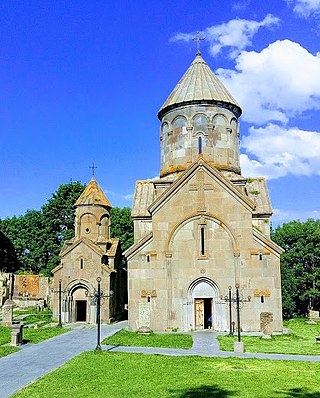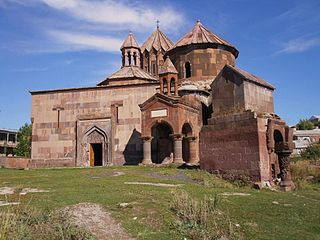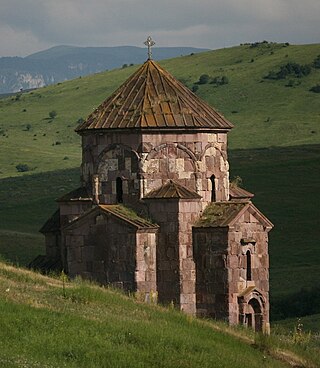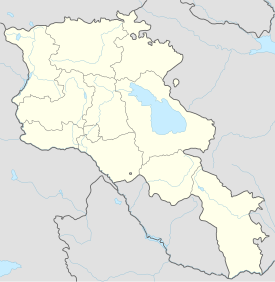
Etchmiadzin Cathedral is the mother church of the Armenian Apostolic Church, located in the city dually known as Etchmiadzin (Ejmiatsin) or Vagharshapat, Armenia. It is usually considered the first cathedral built in ancient Armenia, and often regarded the oldest cathedral in the world.

The Monastery of Saint Thaddeus is an ancient Armenian monastery in the mountainous area of West Azerbaijan Province, Iran. It is believed to be one of the oldest church buildings in the world.

Noravank is a 13th-century Armenian monastery, located 122 km from Yerevan in a narrow gorge made by the Amaghu River, near the town of Yeghegnadzor in Armenia. The gorge is known for its tall, sheer, brick-red cliffs, directly across from the monastery. The monastery is best known for its two-storey Surb Astvatsatsin Church, which grants access to the second floor by way of a narrow stone-made staircase jutting out from the face of building.

Kecharis Monastery, is a medieval Armenian monastic complex dating back to the 11th to 13th centuries, located 60 km from Yerevan, in the ski resort town of Tsaghkadzor in Armenia. Nestled in the Pambak mountains, Kecharis was founded by a Pahlavuni prince in the 11th century, and construction continued until the middle of the 13th century. In the 12th and 13th centuries, Kecharis was a major religious center of Armenia and a place of higher education. Today, the monastery has been fully restored and is clearly visible from the ski slopes.

Saint Hripsime Church is a seventh century Armenian Apostolic church in the city of Vagharshapat (Etchmiadzin), Armenia. It is one of the oldest surviving churches in the country. The church was erected by Catholicos Komitas to replace the original mausoleum built by Catholicos Sahak the Great in 395 AD that contained the remains of the martyred Saint Hripsime to whom the church is dedicated. The current structure was completed in 618 AD. It is known for its fine Armenian-style architecture of the classical period, which has influenced many other Armenian churches since. It was listed as a UNESCO World Heritage Site along with other nearby churches, including Etchmiadzin Cathedral, Armenia's mother church, in 2000.

The Cathedral of Ani is the largest standing building in Ani, the capital city of medieval Bagratid Armenia, located in present-day eastern Turkey, on the border with modern Armenia. Its construction was completed in the early 11th century by the architect Trdat and it was the seat of the Catholicos, the head of the Armenian Apostolic Church, for nearly half a century.

The Harichavank is 7th century Armenian monastery located near the village of Harich in the Shirak Province of Armenia. The village is 3 km southeast of the town of Artik.

Armenian architecture comprises architectural works with an aesthetic or historical connection to the Armenian people. It is difficult to situate this architectural style within precise geographical or chronological limits, but many of its monuments were created in the regions of historical Armenia, the Armenian Highlands. The greatest achievement of Armenian architecture is generally agreed to be its medieval churches and seventh century churches, though there are different opinions precisely in which respects.

Hovhannavank is a medieval monastery located in the village of Ohanavan in the Aragatsotn Province of Armenia. The monastery stands on the edge of the Kasagh River canyon, and its territory is adjacent to the village of Ohanavan. The deep gorge is carved by the Kasagh River.

Zvartnots Cathedral is a medieval Armenian cathedral near Vagharshapat (Ejmiatsin), Armenia. Built in the seventh century and now lying in ruins, Zvartnots was noted for its circular exterior structure, unique in medieval Armenian architecture, and a set of interior piers that upheld a multifloor structure crowned with a dome.

Mastara is a village in the Talin Municipality of the Aragatsotn Province of Armenia. The 5th-century Armenian Church of S. Hovhannes is situated in the northeastern half of the village, while the church of S. Stepanos Nakhava sits on a hilltop to the north. There is also the small medieval Tukh Manuk Church in the village to the southeast.

Bana is a ruined early medieval cathedral in present-day Erzurum Province, eastern Turkey, in what had formerly been a historical marchland known to Armenians as Tayk and to Georgians as Tao.

The Cathedral of Talin is a seventh-century Armenian cathedral located in the cemetery of Talin, in the Aragatsotn Province of Armenia.

The Cathedral of Kars, also known as the Holy Apostles Church is a former Armenian Apostolic church in Kars, eastern Turkey. Built in the mid-10th century by the Armenian Bagratid King Abas I, it was converted into a mosque in 1579. In the 19th and early 20th century it was converted into a Russian Orthodox and later Armenian cathedral. In 1993 it was again converted into a mosque and is called Kümbet Mosque. It currently comprises part of a larger Islamic complex that includes the Evliya Mosque, the biggest mosque in Kars.

The Church of Saint Sarkis in Tekor was a 5th-century Armenian church built in historical Armenia. It was located facing the town of Digor in the Kars Province of Turkey, about 16 kilometers west of the Armenian border. Tekor was a three aisled basilica with a dome. It was severely damaged by earthquakes in 1912 and 1936, and later damaged by vandalism. Now only the lower parts of the rubble and concrete core of the walls remain, the facing stone apparently removed to build the town hall in the 1960s. The inscription dating the building to the 480s was the oldest known writing in the Armenian language.

The Lower Bethlemi Church(Georgian: ქვემო ბეთლემის ეკლესია), also known as the Church of Saint Stepanos of the Holy Virgins or Koosanats Sourb Stepanos Vank) – is a 14th–19th-century church at the foot of Narikala fortress in Old Tbilisi, Georgia. It was rebuilt between 1868 and 1870 and operated as an Armenian church. In 1988 it was given to the Georgian Orthodox and its Armenian identity was "Georgianized" in 1991.

The Kldisubani St. George Church or Qarapi Saint Gevorg church is an 18th-century church at the foot of the Narikala citadel in Old Tbilisi, Georgia. The church is single-naved and was built in 1753. The Georgian Orthodox Church was built on the site of an ancient Georgian church which was built during the reign of St. King Vakhtang I of Iberia. The church was reconstructed with the help of Armenian merchant Petros Zohrabian and his wife Lolita and the restoration held by them in 1735, what makes the church one of the most important examples of Georgian-Armenian friendship and cooperation.

Sanahin Monastery is an Armenian monastery founded in the 10th century in Sanahin in the Lori Province of Armenia.

Holy Mother of God Cathedral of Avan is a ruined 6th-century church located in the Avan District of Yerevan, the capital of Armenia. It is the oldest surviving church inside Yerevan's city limits.

The Holy Mother of God Church of Voskepar is a 7th-century Armenian church in Voskepar, Armenia, adjacent to the border with Azerbaijan. Its design is that of a cruciform central plan, the "Mastara" type. The roof was originally made of tiles. The church was reconstructed in 1975–1977. Despite heavy fighting during the First Nagorno-Karabakh War having spread to the area, and the destruction of the immediately adjacent Azeri village, Aşağı Əskipara, the church still stands.

































